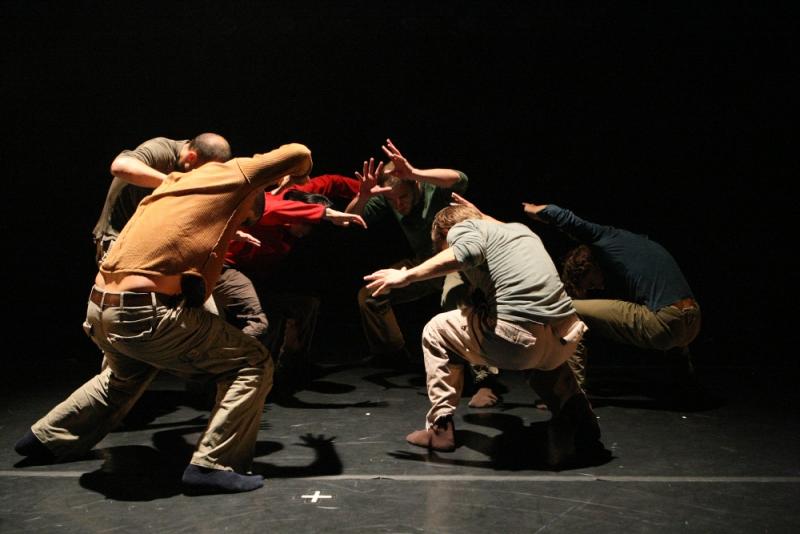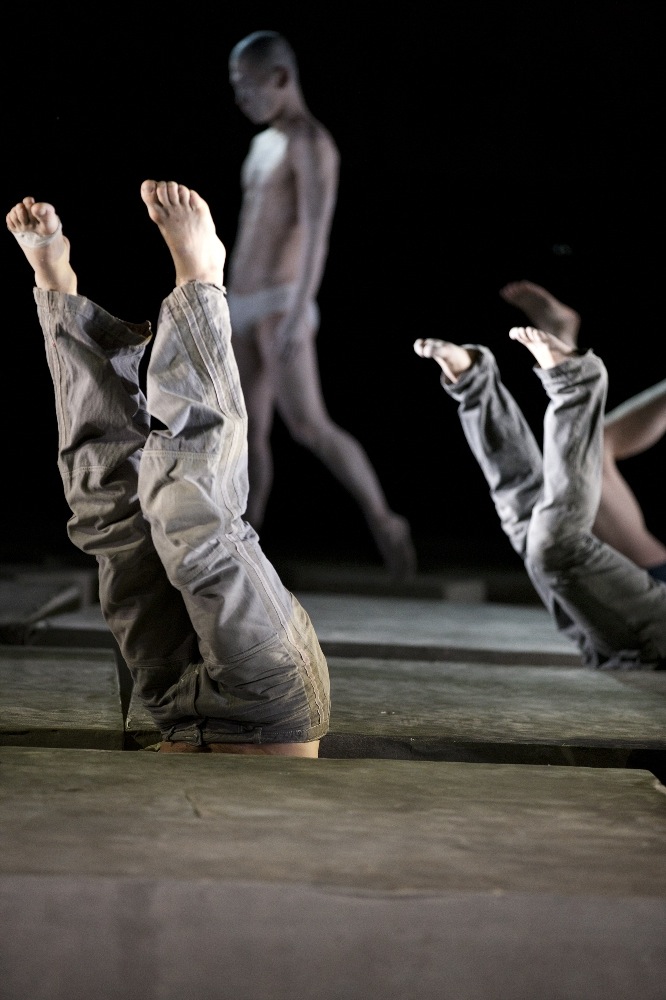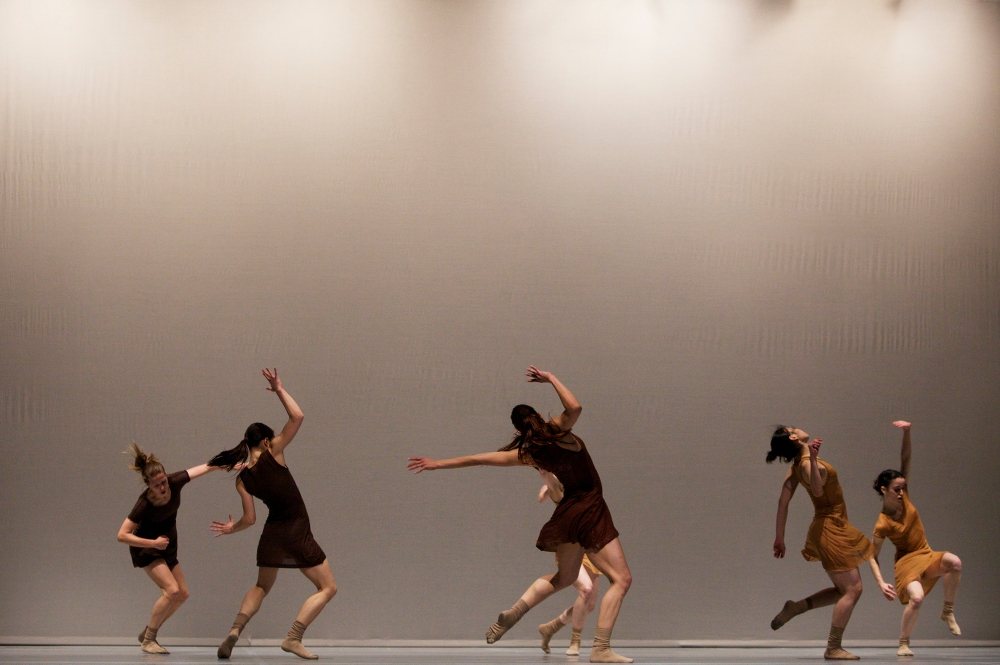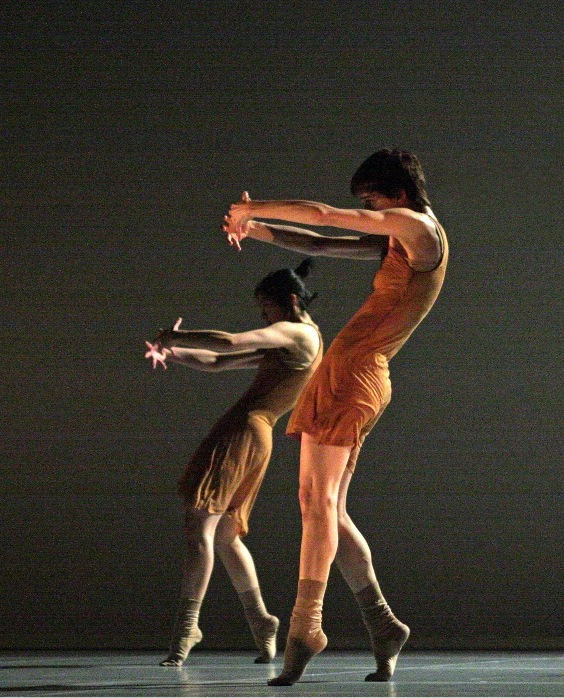Hofesh Shechter/ Sidi Larbi Cherkaoui, Puz/zle, Sadler's Wells | reviews, news & interviews
Hofesh Shechter/ Sidi Larbi Cherkaoui, Puz/zle, Sadler's Wells
Hofesh Shechter/ Sidi Larbi Cherkaoui, Puz/zle, Sadler's Wells
Two big contemporary dance names - one pleases himself, the other pleases his sponsors

I was trying to remember the last time a choreographer actually tried to make the audience smile in the past few months. Dance-lovers are suckers for guilt.
No venue is more a secular church for expiation than Sadler’s Wells, London's dance theatre. Last week it hosted two of the big names of contemporary dance theatre, Sidi Larbi Cherkaoui and Hofesh Shechter. Both were set on atoning for sins, and for psycho-socio-political baggage potential they're equally matched - Cherkaoui, half Belgian, half Moroccan, and Shechter, Israeli but London-based. They also share an earthy street-style of dance that's heavy on the feet and draws on breakdance for its acrobatic dynamics.

But no contest in result: Shechter’s vigour and personal idiosyncrasy were simply more enjoyable than the over-righteous mourning of Cherkaoui, who has done much better work than Puz/zle, his newest creation. (And my four stars are for Shechter.)
Puz/zle originated in a French quarry last year, hence its set of huge slabs and piles of stones, and it attempts to deconstruct the puzzle of human nature with large effects of ant-people and eternal building blocks (pictured above right). From among the ant-people rises the characterful male singing of the Corsican a cappella group A Filetta, further decorated by a honeyed Lebanese alto with luscious hair and a nervy Japanese taiko drummer who also tootles flutes. The flautist is a knowing Puck, luring dancers out of the ant-heap in boneless tumbling solos that seem to be buffeted by the flute-player’s breath.
The live music is beguiling. Distinctively less so the dance performance which for nearly two hours circles around the insoluble matter of universal culpability with visual plays on the wrongs of ancester-worship, stoning dissidents, and the malleability of people when driven by authority. The more sponsors there are, the more generic a work, and this one has to please co-commissioners in London, Antwerp, Avignon, Lille, Luxemburg, Mulhouse, Sankt-Pölten, Rome and Düsseldorf. Fishing policies have had fewer people to keep happy than this piece of dance.
Black-clad dancers swarm over the slabs, reminding one of news pictures from Dhaka at the moment which somewhat trump this as a demonstration of the puzzle of human nature. They build temples, then pull them down and start again. They chain in undulating squiggles that turn 11 dancers into a human millipede. Their docile impersonality contrasts with the heady perfume of Fadia Tomb El-Hage’s siren voice and A Filetta’s spicy Levantine medievalism.
There’s a neat scene where dancers are “sculpted” into life by a sculptor’s hammer (conjured by the artist-qua-politician, ah so). But how much more grippingly visionary and singular was the idea in Cherkaoui’s 2009 Apocrifu, focusing on holy books and religious traditions, so much more human and providing some ecstastic imagery. There's nothing to exhilarate or surprise in this long-winded dance sermon, and it's that which Shechter did show when he took his turn at Sadler's Wells a few days later.
 The Israeli is equally distraught in his double bill over the weekend reviving two past works, one for men, one for women, but here it feels personal, we’re seeing into Shechter’s states of mind. Uprising, his breakthrough piece from 2006, starts with a terrific, melodramatic bang and black-out, and the crouching energy of the seven men’s very fast running movement keeps up a taut tension. The suspense has something of the unpredictability of waiting for the next gunfire. It is studded with pauses, almost immobile, watchful times as the gang seem to halt for orders, disengage, slacken - while you hold your breath waiting for the next sortie.
The Israeli is equally distraught in his double bill over the weekend reviving two past works, one for men, one for women, but here it feels personal, we’re seeing into Shechter’s states of mind. Uprising, his breakthrough piece from 2006, starts with a terrific, melodramatic bang and black-out, and the crouching energy of the seven men’s very fast running movement keeps up a taut tension. The suspense has something of the unpredictability of waiting for the next gunfire. It is studded with pauses, almost immobile, watchful times as the gang seem to halt for orders, disengage, slacken - while you hold your breath waiting for the next sortie.
The sorties are exactly organised, little cells of men breaking off - two run here, three over there, they meld swiftly into five. Breakdancing is a visible influence on their tumbling rise and fall (as, perhaps, is Martha Graham? Shechter began in Batsheva, the Israeli company founded by Graham) but you also imagine they’re keeping low so as not to be picked off by a sniper somewhere.
Shechter is as much a composer as choreographer and has a cunningly theatrical ear for what will shock and discombobulate us. His music is deafeningly percussive, packing the air with remorseless scratch rhythms, slashes, whooshes and other aurally intriguing thuds that sometimes seem actually to agitate the dancers too.
 It’s tense, exhilarating, darkly playful - it’s a barrel of laughs compared to the girls’ one. The Art of Not Looking Back operates to much more painful, experimental visceral effect. An initial male voiceover steers us into the mind of a man abandoned by his mother aged two, and almost comically bloodcurdling screams shatter our ears. Six strong girls in brown gibber like crazy people, mothers on the edge of a nervous breakdown. (Pictured above and left by Dee Conway)
It’s tense, exhilarating, darkly playful - it’s a barrel of laughs compared to the girls’ one. The Art of Not Looking Back operates to much more painful, experimental visceral effect. An initial male voiceover steers us into the mind of a man abandoned by his mother aged two, and almost comically bloodcurdling screams shatter our ears. Six strong girls in brown gibber like crazy people, mothers on the edge of a nervous breakdown. (Pictured above and left by Dee Conway)
The stop-start idiom of Uprising recurs here - order and chaos alternate, the women mooch about listlessly or cohere in a careful ballet class drill. Sometimes the stage is cool, white, the floor gridded in perfect regularity, at other times it’s red like blood (bravura lighting by Lee Curran). Angelic fragments of Bach’s double violin concerto flounder in a sea of horrible noises.
The six women are wholeheartedly strong and watchable, their choreography seems to explore frayed edges and irresolution, rather than firing dynamic missiles of movement like the boys’ one. In the messiness the constant return to ballet barre seems almost a psychological prop, a need for the comfort of known things, which could apply to either mother or child.
I found it absorbing, affecting, and exhilarating - another demonstration of Shechter’s exceptionally focused and assertive theatrical talent. Don’t miss the return of his 2011 Political Mother in July.
- Hofesh Shechter’s Political Mother is at Sadler’s Wells Theatre, London 3-7 July
- A Filetta's website
- Sidi Larbi Cherkaoui's Eastman company website
- Hofesh Shechter website
Watch A Filetta sing a short traditional Corsican Paghjella
rating
Explore topics
Share this article
The future of Arts Journalism
You can stop theartsdesk.com closing!
We urgently need financing to survive. Our fundraising drive has thus far raised £49,000 but we need to reach £100,000 or we will be forced to close. Please contribute here: https://gofund.me/c3f6033d
And if you can forward this information to anyone who might assist, we’d be grateful.

Subscribe to theartsdesk.com
Thank you for continuing to read our work on theartsdesk.com. For unlimited access to every article in its entirety, including our archive of more than 15,000 pieces, we're asking for £5 per month or £40 per year. We feel it's a very good deal, and hope you do too.
To take a subscription now simply click here.
And if you're looking for that extra gift for a friend or family member, why not treat them to a theartsdesk.com gift subscription?
more Dance
 'We are bowled over!' Thank you for your messages of love and support
Much-appreciated words of commendation from readers and the cultural community
'We are bowled over!' Thank you for your messages of love and support
Much-appreciated words of commendation from readers and the cultural community
 Peaky Blinders: The Redemption of Thomas Shelby, Rambert, Sadler's Wells review - exciting dancing, if you can see it
Six TV series reduced to 100 minutes' dance time doesn't quite compute
Peaky Blinders: The Redemption of Thomas Shelby, Rambert, Sadler's Wells review - exciting dancing, if you can see it
Six TV series reduced to 100 minutes' dance time doesn't quite compute
 Giselle, National Ballet of Japan review - return of a classic, refreshed and impeccably danced
First visit by Miyako Yoshida's company leaves you wanting more
Giselle, National Ballet of Japan review - return of a classic, refreshed and impeccably danced
First visit by Miyako Yoshida's company leaves you wanting more
 Quadrophenia, Sadler's Wells review - missed opportunity to give new stage life to a Who classic
The brilliant cast need a tighter score and a stronger narrative
Quadrophenia, Sadler's Wells review - missed opportunity to give new stage life to a Who classic
The brilliant cast need a tighter score and a stronger narrative
 The Midnight Bell, Sadler's Wells review - a first reprise for one of Matthew Bourne's most compelling shows to date
The after-hours lives of the sad and lonely are drawn with compassion, originality and skill
The Midnight Bell, Sadler's Wells review - a first reprise for one of Matthew Bourne's most compelling shows to date
The after-hours lives of the sad and lonely are drawn with compassion, originality and skill
 Ballet to Broadway: Wheeldon Works, Royal Ballet review - the impressive range and reach of Christopher Wheeldon's craft
The title says it: as dancemaker, as creative magnet, the man clearly works his socks off
Ballet to Broadway: Wheeldon Works, Royal Ballet review - the impressive range and reach of Christopher Wheeldon's craft
The title says it: as dancemaker, as creative magnet, the man clearly works his socks off
 The Forsythe Programme, English National Ballet review - brains, beauty and bravura
Once again the veteran choreographer and maverick William Forsythe raises ENB's game
The Forsythe Programme, English National Ballet review - brains, beauty and bravura
Once again the veteran choreographer and maverick William Forsythe raises ENB's game
 Sad Book, Hackney Empire review - What we feel, what we show, and the many ways we deal with sadness
A book about navigating grief feeds into unusual and compelling dance theatre
Sad Book, Hackney Empire review - What we feel, what we show, and the many ways we deal with sadness
A book about navigating grief feeds into unusual and compelling dance theatre
 Balanchine: Three Signature Works, Royal Ballet review - exuberant, joyful, exhilarating
A triumphant triple bill
Balanchine: Three Signature Works, Royal Ballet review - exuberant, joyful, exhilarating
A triumphant triple bill
 Romeo and Juliet, Royal Ballet review - Shakespeare without the words, with music to die for
Kenneth MacMillan's first and best-loved masterpiece turns 60
Romeo and Juliet, Royal Ballet review - Shakespeare without the words, with music to die for
Kenneth MacMillan's first and best-loved masterpiece turns 60
 Help to give theartsdesk a future!
Support our GoFundMe appeal
Help to give theartsdesk a future!
Support our GoFundMe appeal

Add comment